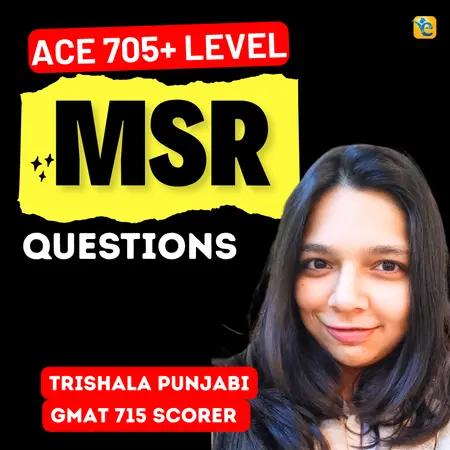Events & Promotions
|
|

GMAT Club Daily Prep
Thank you for using the timer - this advanced tool can estimate your performance and suggest more practice questions. We have subscribed you to Daily Prep Questions via email.
Customized
for You
Track
Your Progress
Practice
Pays
Not interested in getting valuable practice questions and articles delivered to your email? No problem, unsubscribe here.
- Nov 22
11:00 AM IST
-01:00 PM IST
Do RC/MSR passages scare you? e-GMAT is conducting a masterclass to help you learn – Learn effective reading strategies Tackle difficult RC & MSR with confidence Excel in timed test environment - Nov 23
11:00 AM IST
-01:00 PM IST
Attend this free GMAT Algebra Webinar and learn how to master the most challenging Inequalities and Absolute Value problems with ease. - Nov 25
10:00 AM EST
-11:00 AM EST
Prefer video-based learning? The Target Test Prep OnDemand course is a one-of-a-kind video masterclass featuring 400 hours of lecture-style teaching by Scott Woodbury-Stewart, founder of Target Test Prep and one of the most accomplished GMAT instructors.
Kudos
Bookmarks
D
Be sure to select an answer first to save it in the Error Log before revealing the correct answer (OA)!
Difficulty:
 95%
(hard)
95%
(hard)
Question Stats:
49% (03:02) correct 51%
(03:08)
wrong
51%
(03:08)
wrong  based on 1342
sessions
based on 1342
sessions
History
Date
Time
Result
Not Attempted Yet
The figure above shows 2 circles. The larger circle has center A, radius R cm, and is inscribed in a square. The smaller circle has center C, radius r cm, and is tangent to the larger circle at point B and to the square at points D and F. If points A, B, C, and E are collinear, which of the following is equal to R/r ?
A. \(\frac{2}{\sqrt{2} + 1}\)
B. \(\frac{2}{\sqrt{2} - 1}\)
C. \(\frac{2}{2\sqrt{2} + 1}\)
D. \(\frac{\sqrt{2} + 1}{\sqrt{2} - 1}\)
E. \(\frac{2\sqrt{2} + 1}{2\sqrt{2} - 1}\)
PS75571.01
Attachment:
2019-09-21_1753.png [ 27.97 KiB | Viewed 39233 times ]
Kudos
Bookmarks
side of the square = 2R
diagonal of the square = 2√2R
AE = half of the diagonal of the square (A, B, C, and E are collinear and lies on the diagonal of the square)
AE = √2R
AE = AB+BC+CE
√2R = R+r+√2r (BC = r--radius of small circle CE = diagonal of small square)
R(√2-1) = r(√2+1)
\(\frac{R}{r}\) = \(\frac{√2+1}{√2-1}\)
D is the answer
diagonal of the square = 2√2R
AE = half of the diagonal of the square (A, B, C, and E are collinear and lies on the diagonal of the square)
AE = √2R
AE = AB+BC+CE
√2R = R+r+√2r (BC = r--radius of small circle CE = diagonal of small square)
R(√2-1) = r(√2+1)
\(\frac{R}{r}\) = \(\frac{√2+1}{√2-1}\)
D is the answer
Attachments
ps4.png [ 13.75 KiB | Viewed 36194 times ]
Kudos
Bookmarks
gmatt1476
The big and the small squares are similar to each other, so we can set up an equation between the ratio of their side lengths and the ratio of their diagonals.
\(\frac{2R}{r}=\frac{2(R+r+r\sqrt{2})}{r\sqrt{2}}\)
\(R\sqrt{2}-R=r+r\sqrt{2}\)
\(R(\sqrt{2}-1)=r(1+\sqrt{2})\)
\(\frac{R}{r}=\frac{1+\sqrt{2}}{\sqrt{2}-1}\)
Answer: D















